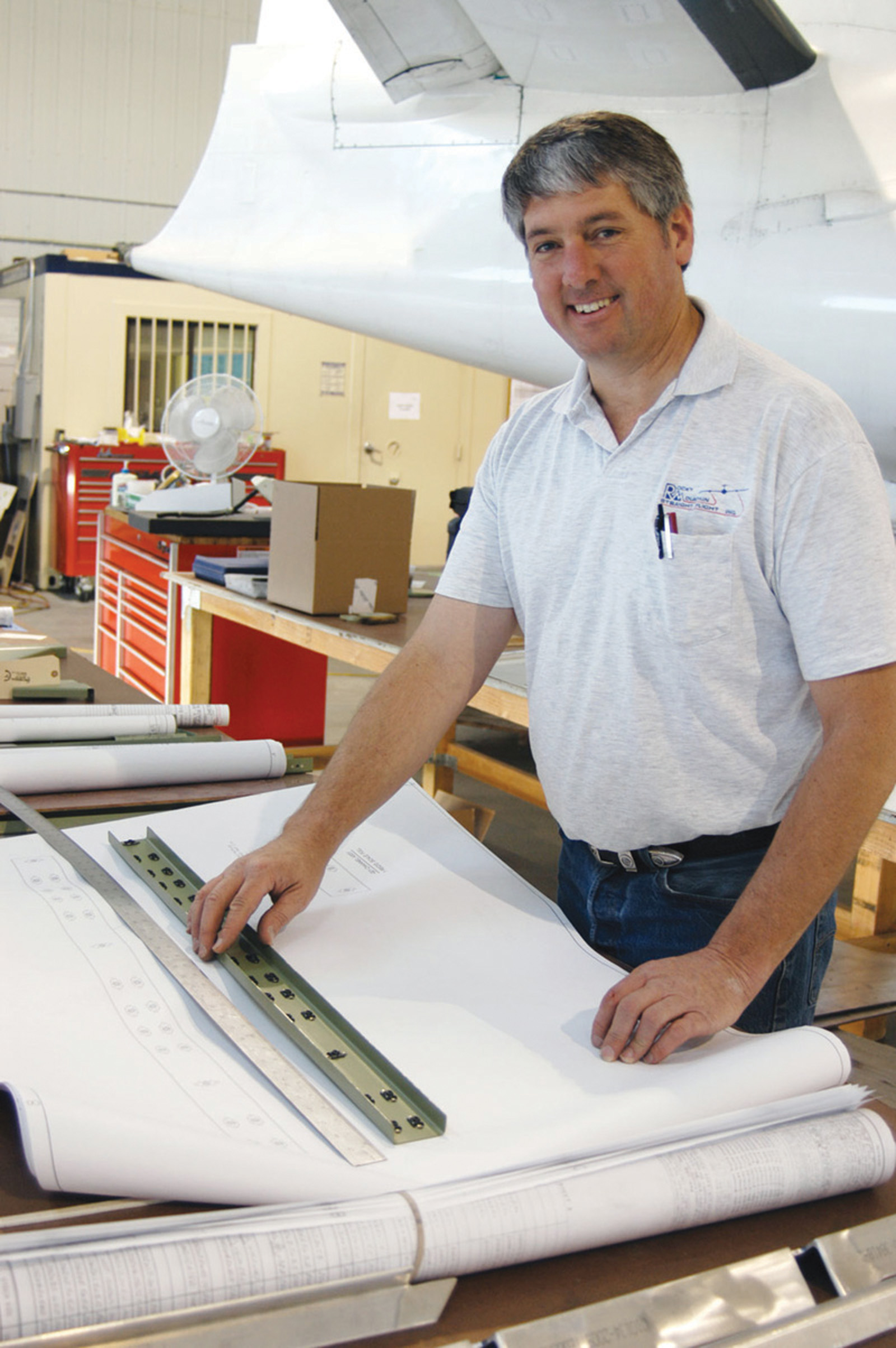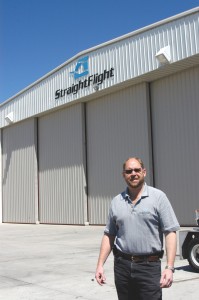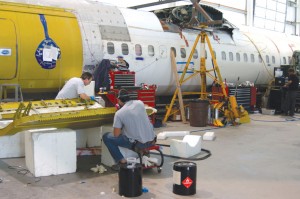By Shari Valenta
Business Spotlight

Stan Mounce, co-owner of Straight Flight Conversion, spends a lot of time making sure the parts of the converted Fokker 50 conform to drawings.
An experienced pilot who worked for the state of Colorado parked his King Air on the tarmac at Granby County Airport, after dropping off former Governor Roy Romer. The airman filled out some paperwork and then picked up a couple of wheel chalks to keep his airplane in place. Too late, out of the corner of his eye, he saw something traveling backwards down the ramp. The King Air was rapidly heading backwards, downhill towards a steep ravine.
“Oh, no!” shouted the pilot, chasing after the aircraft as it rolled away.
He grabbed the plane and held it as it drags him, wearing the rubber off his shoe bottoms. At the edge of the hill, the aircraft finally stopped. Beads of sweat rolled down his forehead as he held the nose gear of the plane. Then momentum took its course; the nose bobbed up and down while the pilot desperately tried to keep a grip. He realized he might fall with the plane, so he finally let go. Suddenly, the once radiant transporter of VIPs plunged, and then bounced down the ravine. Sharp boulders pierced its belly and buckled the tail.
Stan Mounce and Ernie Smith, co-owners of Straight Flight, Inc., were sped to the scene in a state patrol car. The experienced aviation mechanics decided to have two cranes pull the plane out of its unwelcoming grave. They patched it up for a ferry flight back to their repair shop, with the gear locked down.
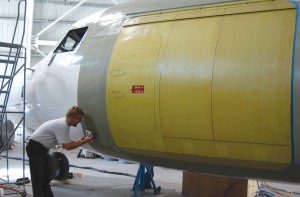
Mike Sotherden, chief mechanic, completes the final touches to the cargo door installation. This involves removing the existing three-foot-wide door and installing one that is nine feet wide.
Straight Flight and Straight Flight Conversions
Located at Centennial Airport, Straight Flight turns many misfortunes into miracles. Many pilots depend on the company, specializing in aircraft maintenance and major structural repair, as their one-stop airframe repair and modification facility. An FAA certified repair station with quite an extensive rating, Straight Flight does structural repairs generally related to insurance work, such as hail damage and gear-up landings.
“We do a variety of inspection work on just about anything that flies,” Smith said. “We also do our own in-house milling. We have a lot of repair fixtures and many tools for the fabrication of custom parts, and we probably have the largest inventory of fabrication equipment on the airport.”
Mounce and Smith met while working as sheet metal mechanics for Branson Aircraft at Stapleton Airport in the early 1980s. The idea to start their own business developed one day in 1986, as they were having lunch with Mel Eisaman, an inspector for Branson who also became a business partner for a period of time.
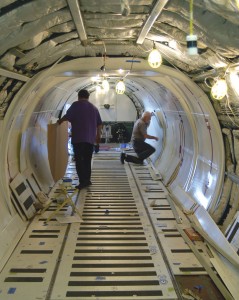
The Straight Flight Conversion crew completes the installation of e-class cargo liner configuration.
“We wanted to see if we could make a little extra money on the side, and decided we wanted to start a little business, so we spent $40 on a box of business cards,” said Smith.
For many years, the company, first known as Rocky Mountain Straight Flight, occupied the Denver jetCenter East building (where Flight Options is now located). In 2000, the owners shortened the company name but increased the work area, building a 24,000-square-foot facility with 15,000 square feet of hangar space.
Smith is happy he made the decision to start an aircraft repair and maintenance shop.
“It’s pretty cool to take a damaged airplane and restore it back to flying condition, so the only way you’d ever know it had an incident is to look in the logbooks,” he said.
Mounce and Smith also own Straight Flight Conversions. Its focus is to modify Fokker 50 twin-engine, turboprop airplanes that seat 60 people, from passenger to cargo aircraft. Because of the scope of these projects, the owners decided to create a separate business and hired additional mechanics. Collectively, the two businesses have about 30 employees.

Straight Flight Conversions modifies Fokker 50 twin-engine, turboprop airplanes from passenger to cargo aircraft.
“Although Ernie and I felt that our hangar could support the airplane and the project, we felt that bringing it into our hangar would have affected our existing customer base,” said Mounce. “We thought it wasn’t fair to throw them aside because of this large project, so we developed Straight Flight Conversions. It has completely separate employees, but is managed with the same principles of Straight Flight.”
Both of the companies are FAA certified. They’re currently in the process of being European Aviation Safety Agency approved for their European Repair Station Certificate.
To modify the aircraft, passenger seats are removed and a complete liner system is installed in the interior with 9-G vertical separation nets to keep cargo in place. The aircraft essentially goes through an entire makeover to become a certified cargo ship. Several contracted support companies (some international) develop the required engineering and drafting package before the modifications are done physically. Developing the AutoCAD drawings and electronic stress models required by both the FAA & EASA for final supplemental type certificate approval is a process of thousands of hours. An STC is issued when the FAA approves a request to modify an aircraft from its original design.
“The entire existing passenger interior is removed,” explained Mounce. “We start with removal of the three-foot, drop-down passenger door, and then add a new large cargo door and supporting structure. We do this by manufacturing the parts here designed by our engineering group. We have under-the-floor modifications—cargo liner modifications—because the floors and side walls were designed for passengers.”
The large cargo door is slightly larger than the nine-foot square contoured to the aircraft fuselage.
“We have to modify the existing pressurization system of the aircraft,” he said. “Another thing we do is remove the passenger windows and replace them with machined aluminum plugs. We also relocate the batteries from under the floor in the front to the aft of the aircraft.”

Straight Flight’s 15,000-square-foot hangar has ample room to perform aircraft maintenance and structural repair.
You might ask, “Wouldn’t it be cheaper to just buy a new cargo airplane?” Mounce explained that all airplanes must be modified to carry cargo.
“You can’t buy airplanes with cargo doors in them,” he said. “No airplane manufacturers install cargo doors, because they aren’t configured for cargo. Every cargo airplane you see is something that’s been modified by companies like ours. This airplane, at the time it was built, was too expensive to modify for cargo, so it was better suited for passenger configuration. Now, the prices of these older airplanes are going down, so people can afford to purchase them for cargo operation.”
In 2003, Aircraft Conversions, a Dutch company based out of International Airport Schipol in the Netherlands, approached Mounce and Smith regarding this type of modification. They were able to incorporate the existing STC modification of a door for the Fairchild FH227 for their project. The Fokker 50 airplane was originally a Dutch design, but the FH227 works well, according to Mounce, because it’s the American version. The business partners worked on it at Branson Aircraft, so they were already experienced with the installation, which is why Aircraft Conversions approached them for the job. The technicians at Straight Flight Conversions first installed the door on a test aircraft fuselage.
“The FAA requires that we test the installation to the extreme limit on the aircraft, due to the level of the modification,” Mounce said. “We didn’t want to destroy or hurt an actual customer’s aircraft, so we purchased a Fokker 50 fuselage that was being dismantled for its rotable parts. We had the wings, nose and tail feathers cut off and shipped from Holland, to the Port of Houston, to here, our test bed.”
They loaded the aircraft with 20,000 pounds of weight, forward and back, and did proof-bend tests to verify their structural design wouldn’t fail with the cargo door installed, while under maximum pressure differential.
“We literally bent it four inches to see what would happen when you took an airplane designed for passenger use, with a three-foot-wide door, and then changed it to a nine-foot-wide door,” he said. “It’s a huge hole, so we had to make sure the plane didn’t structurally fail due to poor design and pressurization loads.”
They built a fort around the airplane, using huge foam blocks for safety, in the event it blew up during its pressurization test.
“We also put the blocks on the inside of the airplane to displace the air, so if the airplane did blow up, there wouldn’t be as much force due to less air inside,” he said. “Installation and testing the fuselage was a big job; we spent more than a half million dollars.”
They spent $10,000 just on the foam blocks.
“Now it just sits here and you can’t do anything with it. I call it lawn art now,” Mounce chuckled.
It was difficult to transport the test fuselage to Straight Flight Conversion due to the sheer size of the fuselage. Smith said they had to transport the wide load from Texas during a major spring snowstorm.
“It was funny,'” said Mounce. “We called UPS and said, ‘Hey, we need to ship an airplane.’ They said, ‘What?’ We said, ‘Your commercials say you can ship anything anywhere, right?’ They replied, ‘We can.’ The airplane was loaded by crane onto a container ship. Then, cargo pods were stacked around the airframe to protect it while it was being shipped. It took about three weeks to get here.”
Straight Flight Conversions completed their first modified Fokker 50 in August. Mounce is happy with his decision to take on the project.
It’s a challenge, but I like it,” said Mounce. “It was hectic when we were in the process of research and development, because there was so much money involved to design and build it. But after that was done, we were able to forget it all and simply build airplanes.”
Straight Flight is located at 13251 E. Control Tower Rd. For more information, call 303-799-8906 or visit www.straightflight.com. Straight Flight Conversions is located at 13400 E. Control Tower Rd. For more information, call 303-662-8961 or visit [http://www.aircraftconversions.com].











